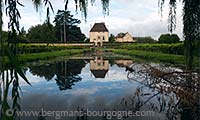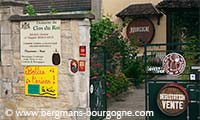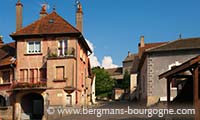
alfway between Dijon and Beaune is Nuits-Saint-Georges, a small town with some 5000 inhabitants. This is the centre of Côte de Nuits, though not geographically. North of Nuits-Saint-Georges is the long string of red grand crus; from Romanée-Conti to Chambertin. South of the town are three villages without appellations of their own – Premeaux-Prissey, Comblanchien and Corgoloin.
 The RN74 leads straight through Nuits-Saint-Georges. When entering the town from the south the road makes a sharp bend to the right across the Place de la Libertion. There is a fountain right in the middle of the square and behind it, on the Quai Fleury, you can park your car.
The RN74 leads straight through Nuits-Saint-Georges. When entering the town from the south the road makes a sharp bend to the right across the Place de la Libertion. There is a fountain right in the middle of the square and behind it, on the Quai Fleury, you can park your car.
There are a large number of shops and cafés/restaurants here. So if you feel like strolling the streets or just being lazy at a café Nuits-Saint-Georges is a good place to go. Market day is Friday and there are many wine growers' cellars within walking distance.
Just a block away from the fountain, on Rue Crébillon, is Le Cavon de Bacchus. This is a small wine shop, but only in size. The number of wines and the knowledge is considerable. And the passion, I should add. Madame who runs the place is very passionate about her work and I have learnt along the years that her recommendations are something to trust.
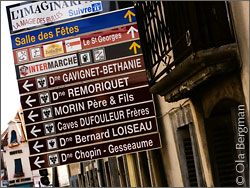
Southeast of Nuits-Saint-Georges is Les Bolards, a settlement dating back to Gallo-Roman times. Some of the archaeological findings are on display at the Musée de Nuits-Saint-Georges – 12, rue Camille Rodier – where you also can learn more about local history.
There are another two museums in Nuits-Saint-Georges; both displaying the local produce – Le Cassissium on Rue des frères Montgolfier and l'Imaginarium on Avenue du Jura. As the name suggests Le Cassissium deals with Crème de Cassis in all aspects, while l'Imaginarium is dedicated to sparkling wine in general and Crémant de Bourgogne in particular.
East of the town centre, close to the motorway, is a large industrial zone with a large variety of activities, including large négociants and fruit juice manufacturers. Continue through this zone and under the A31 and you will soon be in Citeaux with its famous monastery.
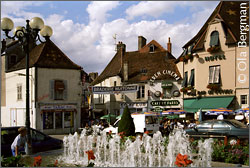 Here, on the plain between Nuits-Saint-Georges and the Saône, you find a handful of small villages.
Here, on the plain between Nuits-Saint-Georges and the Saône, you find a handful of small villages.
Agencourt with its 13th castle and church.
Boncourt-le-Bois with its castle – château de la Berchère – built by the Dukes of Burgundy in the 15th century. During the Franco-Prussian War 1870-1871 the castle was occupied and used as headquarters by the Germans. Then , during World War II it was once again occupied. Since 1980's the castle has been run as a hotel. Argilly and its hamlet Antilly dates back to Gallo-Roman times. In he 12th century the hunting house of Dukes of Burgundy was converted into a castle with 14 towers. It later destroyed in 1590, but the ruins still remain.
 Villy-le-Moutier – split in two, Villy-le-Moutier and Villy-le-Brûlé, by the river Meuzin – was a crossroad during the Gallo-Roman period. Here the Lyon-Trève road crossed the Besançon-Orléans road. Today the A36 motorway runs just north of the village.
Villy-le-Moutier – split in two, Villy-le-Moutier and Villy-le-Brûlé, by the river Meuzin – was a crossroad during the Gallo-Roman period. Here the Lyon-Trève road crossed the Besançon-Orléans road. Today the A36 motorway runs just north of the village.
As many other villages along the Côte d'Or Nuits attached the name of one of its vineyards to its own name during the 19th century. In 1892 Nuits took on the name of the premier cru at the southern end of the commune and became Nuits-Saint-Georges. Before that the name was Nuits-sous-Beaune.
The origin of the Nuits part of the name is uncertain. It does not however have anything to do with nights. Instead it may be a corruption of the Celtic un win, meaning a stream in a valley. It may also be referring to the hazelnut and walnut trees that surrounded the earliest settlements up near the Charmois forest.
There is a small amount – less than two percent of the total production – of white Nuits-Saint-Georges made; Domaine Henri Gouges makes it from a mutated pinot noir producing white grapes, while others use chardonnay as well as pinot blanc and pinot beurot.
The old postcard above, from the early 20th century, shows the park Jardin de l'Arguebuse, just behind the town hall.
© 2013 Ola Bergman










